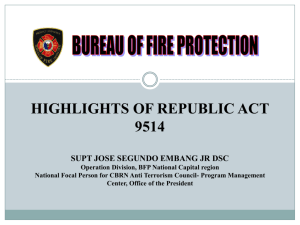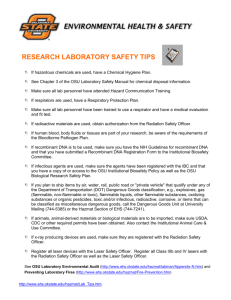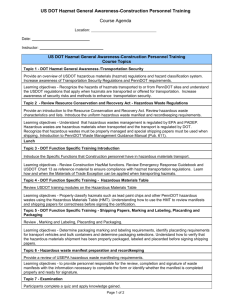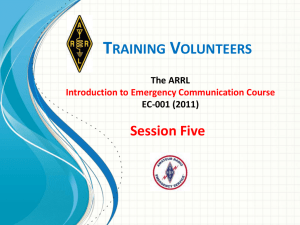Hazardous Materials Transportation General Awareness Training
advertisement
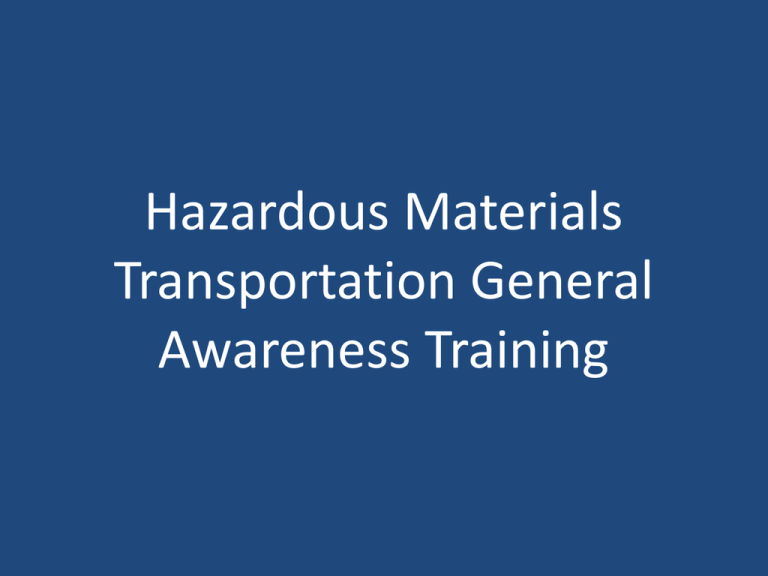
Hazardous Materials Transportation General Awareness Training General Awareness Objectives • Provide employees with: • General requirements of U.S. Department of Transportation (DOT) Hazardous Materials Regulations (HMR) • The ability to recognize and identify hazardous materials (hazmat) using hazard communication methods 2 Who Must Take This Training? • Employees who transport hazmat • Employees who prepare hazmat for transport • Employees who load, unload, or handle hazmat for transport • Employees who are responsible for the safe transport of hazmat 3 This Training is Required When Transporting: • Gasoline, mixed gas, or drip-torch fuel in containers larger than 8 gallons • Diesel in containers larger than 119 gallons • More than 440 total pounds of hazmat in a single vehicle (except diesel in containers 119 gallons or smaller) 4 Examples of Common Hazmat Hazmat Type of Hazard Gasoline Flammable liquid Drip-torch fuel Flammable liquid Diesel Flammable liquid Propane Flammable gas Fusees Flammable solid Flares Flammable solid Plastic spheres Oxidizer 5 DOT Hazardous Materials Table 6 DOT Hazardous Materials Table • Located in Title 49 of the Code of Federal Regulations (CFR) 172.101 (DOT HMR) • Lists materials DOT designates as hazmat for purposes of transportation • Provides information needed for shipping papers, packaging, marking, and labeling • Divided into 10 columns 7 8 Column 1—Symbols • Each symbol designates specific transportation conditions. • There are six specific symbols: • • • • • • + A D G I W 9 Symbol Meaning + May not change the shipping name, hazard class, or packing group even if the hazmat does not meet the hazard class definition. A Regulated only if transported by air unless material is a hazardous substance as defined by DOT or is a hazardous waste. D Identifies requirements only for domestic transport of hazmat. G Identifies generic shipping name. Technical name must be added in parentheses. I Identifies requirements for international and domestic transport of hazmat. W Regulated only if transported by water unless material is a hazardous substance as defined by DOT or is a 10 hazardous waste. Column 2—Hazardous Materials Descriptions and Proper Shipping Names • Lists proper shipping names • Information from this column is used on shipping papers and for marking containers 11 Proper Shipping Names • Shown in Roman type • May be: • Singular or plural • Uppercase, lowercase, or a combination of both • Punctuation marks and italics • Not part of the proper shipping name • Not required to be shown • May be used in addition to the proper shipping name 12 Proper Shipping Name Examples • FLAMMABLE LIQUIDS N.O.S. • Flammable Liquids, n.o.s. • flammable liquids nos N.O.S. = Not Otherwise Specified 13 Column 3—Hazard Class or Division • Designates the hazard class or division of hazmat • Information from this column is used on shipping papers • Examples: • • • • • Division 2.1 = Flammable gas Class 3 = Flammable liquids Division 4.1 = Flammable solids Division 5.1 = Oxidizers Division 6.1 = Poisonous materials 14 Column 4—Identification Numbers • Lists the 4-digit identification number assigned to each hazardous material. • Two types of identification numbers are used: • United Nations (UN) • North America (NA) • UN numbers may be used for domestic and international transport of hazmat. • NA numbers may be used only for domestic (U.S.) transport of hazmat. 15 Diesel Fuel Is an Example of Hazmat With Two Identification Numbers • NA 1993 for domestic transport only • UN 1202 for international and domestic transport 16 Identification Numbers Are Used on the Following: • Shipping papers • Container markings • Placards 17 Column 5—Packing Group (PG) • Indicates the degree of danger • Must always be indicated with Roman numerals • I = Great danger • II = Medium danger • III = Minor danger • Information from this column is required on shipping papers 18 Column 6—Label Codes • Specifies codes that represent hazard warning labels • Examples: • • • • 2.1 = Flammable gas 3 = Flammable liquids 4.1 = Flammable solids 5.1 = Oxidizers 19 Column 7—Special Provisions • Identifies special provisions in addition to standard requirements • Meanings of special provision codes are shown in 49 CFR 172.102 20 Column 8—Packaging • Identifies packaging (containers, tanks, boxes, etc.) requirements for transporting hazmat • The column is divided into three parts: • 8A—Exceptions to requirements in columns 8B and 8C • 8B—Nonbulk packaging requirements • 8C—Bulk packaging requirements • The numbers given in each column correspond to the section number of 49 CFR Part 173 • Example: Exceptions (column 8A) for gasoline are found in 49 CFR 173.150 21 Column 9—Quantity Limitations Identifies the quantity limitations for the air and rail transport of hazmat 22 Column 10—Vessel Stowage Identifies location and special stowage requirements for transporting hazmat by vessel 23 Packaging 24 Definition—Packaging The containers or receptacles hazmat is transported in include: • • • • • Jerricans Drums Tanks Boxes Gas cylinders 25 Definition—Package • Packaging, including contents • • • • A Jerrican containing gasoline A box of plastic spheres used for aerial ignition A box of fusees A gas cylinder containing propane 26 Packaging requirements for each hazardous material are specified in column 8 of the Hazardous Materials Table (49 CFR 172.101). 27 Packaging Types 28 Nonbulk Packaging • Maximum: • Capacity of 119 gallons or smaller for liquids • Weight of 882 pounds and capacity of 119 gallons or smaller for solids • Water capacity of 1,000 pounds or smaller for a gas • Examples: • Jerricans • 55 gallon drums • Tanks smaller than 119 gallons 29 Bulk Packaging More than: • 119-gallon capacity for liquids • 882 pounds or 119-gallon capacity for solids • 1,000-pound water capacity for a gas • Example: Tanks larger than 119-gallon capacity used for terra torches and batch mixers 30 UN Standard Packaging • Required for the transport of more than 440 pounds of most hazmat in a single vehicle or when any individual package is more than 8 gallons or 66 pounds (including the packaging) • Must meet the test requirements of 49 CFR Part 178 • Must be marked with the UN certification mark 31 Example of a UN certification mark found on the bottom of a metal Jerrican 32 Meaning of Jerrican UN Certification Mark • Example: UN 3A1/Y/100/03 USA/M5010 MM.8, where: • • • • • • • • • • UN = United Nations 3 = Jerrican A = Steel 1 = Nonremovable head Y = For use with packing group II and III hazmat 100 = Test pressure in kilopascals (kPa) 03 = Year of manufacture USA = Manufactured and marked in the United States M5010 = Symbol of manufacturer or testing facility MM.8 = Thickness of material in millimeters 33 Preparing a Package for Transport • Leave space for expansion of liquids. • Ensure containers are tightly closed. • Containers must be: • • • • • Leak tight for liquids Sift proof for solids Securely closed Secured against shifting Protected from damage • Inspect containers, caps, gaskets, O-rings, and seals for damage. • Repair or replace damaged containers before transporting. 34 Damaged or Leaking Containers May Be Transported in a Removable Head Drum • Must be a specification drum (example: UN 1A2) • Drum must contain absorbent and cushioning material if needed to prevent excess movement and absorb free liquid— absorbent and cushioning material must be compatible with the hazmat • Drum must be marked as follows: • • • • Proper shipping name (see column 2 of the Hazardous Materials Table) Name and address of hazmat owner “Salvage” or “Salvage Drum” Labeled with hazard class label • Shipping papers may be necessary 35 Overpacks • Overpacks consolidate several packages that could be shipped individually into a single unit. • Each individual package must meet DOT requirements. • The overpack must be labeled and marked with the contents of the individual packages and the word “OVERPACK.” This label is not required if the marking and labeling of the inside packages are visible. • The overpack must be marked with orientation arrows if liquids are packed in nonbulk packaging. 36 Residues • Definition—The hazmat remaining in a container after the container is emptied to its maximum extent. • A transported package containing residue must be treated in the same manner as if the package were full. • Nonbulk packaging (119 gallons or smaller) containing residue does not need to be listed on shipping papers if the packaging will be reused. 37 Exceptions • • • • Allow deviations from some HMR Listed in 49 CFR and applied on a general basis May waive packaging and other requirements Common exceptions: • Materials of Trade • Small quantity • Limited quantity 38 Materials of Trade Exception • Allows use of some containers that do not meet UN specifications • Waives training requirements • Waives labeling requirements • Limited to 440 total pounds of all hazmat in a single vehicle (including packaging) • Individual liquid container size limited to no more than 8 gallons • Individual solid container size limited to no more than 66 pounds • Individual gas cylinder size limited to no more than 220 pounds 39 Small Quantity Exception • Allows shipping of small packages of hazmat (typically 1 ounce or less) inside a “strong outer packaging” • Maximum total package weight must not exceed 64 pounds • Example: Plastic spheres used for aerial ignition packed inside a strong cardboard box 40 Limited Quantity Exception • Allows shipping of small nonspecification containers or fuel inside a strong outer packaging • Maximum total package weight must not exceed 66 pounds • Example: Sigg bottles packed inside a strong cardboard box 41 Special Permits • Provide a waiver from specific DOT requirements • Issued on a case-by-case basis to manufacturers, shippers, etc. • Each special permit has its own number • Example: DOT-SP 11911 issued to Transfer Flow allows their tanks to be used to transport flammable liquids, such as gasoline and driptorch fuel 42 Labeling 43 Reason for Labeling To allow emergency response personnel and employees to identify a hazard in the event of an accident 44 Label codes are specified in column 6 of the Hazardous Materials Table. 45 Examples of Labels • Flammable liquid (gasoline, drip-torch fuel, diesel) • Flammable solid (fusees, flares) • Oxidizer (plastic spheres for aerial ignition) 46 What Must Be Labeled • Nonbulk packagings, such as: • • • • Jerricans Drums Tanks 119 gallons or smaller Boxes of solid hazmat, such as fusees, flares, etc. • Hazardous materials overpacks 47 What Does Not Need To Be Labeled • Tanks larger than 119 gallons • New, unused packagings • Packagings completely cleaned and purged of all residue • Some packagings shipped under Materials of Trade, small quantity, and limited quantity exceptions 48 Location of Labels • Must be on the same surface as the proper shipping name if the package size and shape permit • Must not be obscured by other labels, markings, etc. • Must be affixed to a background of contrasting color or have a dotted- or solidline border around the label 49 Marking Nonbulk Packagings 50 Purpose of Markings Provides a nationally recognized way to identify the contents of a container • For use by employees and emergency response personnel 51 Markings Required for Nonbulk Packaging • Proper shipping name from column 2 of the Hazardous Materials Table • Technical name, if required • Identification number from column 4 of the Hazardous Materials Table 52 Example Marking for Drip-Torch Fuel FLAMMABLE LIQUIDS NOS (DIESEL GASOLINE MIXTURE) UN 1993 Where: • Proper shipping name = FLAMMABLE LIQUIDS NOS • Technical name = (DIESEL GASOLINE MIXTURE) • Identification number = UN 1993 53 Marking Methods 54 Container, Rack, or Holder Stenciling 55 Parts of a Label Label Marking 56 Tags 57 Orientation Arrows • Required if liquid hazmat is packaged inside an outer package • Must be affixed to two opposite vertical sides 58 Markings Must Be: • On a background of sharply contrasting color • Not obscured by other labels or attachments • Far enough away from other labels and signs to avoid confusion • Written in English • Maintained in good condition 59 Placarding 60 Purpose Allows emergency responders to quickly and accurately identify hazmat in the event of an accident 61 The type of placard required is determined by the hazard class or division specified in column 3 of the Hazardous Materials Table. 62 Specific placards are identified in Tables 1 and 2 of 49 CFR 172.504. 63 Placarding Is Required for: • Any tank larger than 119 gallons containing hazmat • Any package containing solid hazmat that weighs more than 882 pounds or is larger than 119 gallons • Any gas cylinder with a water capacity of more than 1,000 pounds • A load of hazmat in a single vehicle that weighs 1,001 pounds or more, regardless of container size 64 Placarding Is Not Required For: • Tanks smaller than 119 gallons • Most hazmat, such as gasoline and drip-torch fuel, in nonbulk containers when the total weight being transported in a single vehicle is less than 1,001 pounds • Diesel in nonbulk containers, regardless of the total weight being transported • Transporting residue in nonbulk containers 65 When Installing Placards, the Placards Must Be: • Installed on each side and end of the tank or transport vehicle with the text horizontal • Located clear of obstructions • Installed at least 3 inches from any other type of marking • Located so the vehicle wheels do not direct dirt and water on them • Fixed to a background of contrasting color • Securely attached • Maintained in good condition 66 Identification Numbers 67 Specified in column 4 of the Hazardous Materials Table 68 May Be Displayed in One of Two Ways: • On a separate panel • As part of a placard 69 Must Be Replaced If Any One Of The Numbers Is Damaged 70 Examples of Placards • Flammable (gasoline, drip-torch fuel) • Flammable solid (fusees, flares) 71 Emergency Shutoff Marking • Required marking: “Emergency Shutoff” • Marking size: minimum ¾-inch letters • Location: Immediately adjacent to the emergency shutoff valve 72 Shipping Papers 73 Purpose—To provide emergency personnel with information on the type and amount of hazmat being transported so they can respond correctly in the event of an accident. 74 Format • No specific format required for hazmat • Hazardous Waste Manifest (Environmental Protection Agency Form 8700-22) required only if the material is waste SHIPPING PAPER MOTOR CARRIER DATE U.S. DEPARTMENT OF AGRICULTURE FOREST SERVICE NUMBER & TYPE OF CONTAINER 10 Jerricans 2 Drums 30 Drip Torches DESCRIPTION OF HAZARDOUS MATERIALS ( ID No., Proper Shipping Name, Hazard Class, Packing Group) QUANTITY 50 Gallons UN 1203, Gasoline, 3, PG II UN 1993, Flammable liquids, n.o.s. (diesel gasoline mixture), 110 Gallons 3, PG II UN 1993, Flammable liquids, n.o.s. (diesel gasoline mixture), 38 Gallons 3, PG II EMERGENCY RESPONSE TELEPHONE NUMBER: (123) 456-7890 NAME IDENTIFIED WITH NUMBER 75 Required for All Hazmat Shipments Except: • Materials of Trade shipments • 440 pounds or less of hazmat in a single vehicle • No liquid containers larger than 8 gallons • No solid packaging larger than 66 pounds • Shipments of diesel in containers 119 gallons or smaller • Small or Limited Quantity exceptions • Other exceptions as defined by DOT 76 General Requirements for Shipping Papers • Must be in English • Must be legible • No codes or abbreviations unless allowed by DOT 77 Information Required on Shipping Paper • Number and type of packaging • Basic description • • • • Identification number Proper shipping name Hazard class or division Packing group • Total quantity of hazmat • Emergency response telephone number • Date of acceptance by carrier 78 Information Required on Shipping Papers—Number and Type of Packaging • Packaging specification may be included but is not required • Examples: • 12 Jerricans • 12 UN 3A1 Jerricans 79 Information Required on Shipping Papers—Basic Description Information in the basic description must be listed in the following order: • • • • Identification number Proper shipping name Hazard class or division Packing group 80 Basic Description—Identification Number • Listed in column 4 of the Hazardous Materials Table • Examples: • Gasoline—UN 1203 • Drip-torch fuel—UN 1993 • Diesel—UN 1202 81 Basic Description—Proper Shipping Name • Listed in column 2 of the Hazardous Materials Table. • If column 1 of the Hazardous Materials Table contains a “G” (for generic shipping name), then the proper shipping name from column 2 must be accompanied by a technical name in parentheses describing the hazardous contents. 82 Basic Description—Proper Shipping Name Examples • Proper shipping name: • Gasoline • Proper shipping name for drip-torch fuel accompanied by a technical name: • Flammable Liquids n.o.s. (Diesel Gasoline Mixture) 83 Basic Description—Hazard Class or Division • Listed in column 3 of the Hazardous Materials Table • Examples: • The hazard class is 3 for gasoline, drip-torch fuel, and diesel. • The hazard division is 4.1 for fusees and flares. 84 Basic Description—Packing Group • Listed in column 5 of the Hazardous Materials Table • Examples: • The packing group is PG II for gasoline and driptorch fuel. • The packing group is PG II for fusees. 85 Basic Description—For Containers Transporting Only Residues If a container contains only residues, the words “RESIDUE: Last Contained” may precede the basic description. 86 Example Basic Descriptions • For gasoline: • UN 1203, Gasoline, 3, PG II • For drip-torch fuel: • UN 1993, Flammable liquids, n.o.s. (diesel gasoline mixture), 3, PG II • For diesel: • UN 1202, Diesel fuel, 3, PG III • For fusees: • NA 1325, Fusee, 4.1, PG II • For an empty container last used to transport gasoline: • RESIDUE: Last Contained, UN 1203, Gasoline, 3, PG II 87 Total Quantity of Hazardous Material • Indicated in gallons for liquids or pounds for solids • Must include unit of measure • Tanks larger than 119 gallons may be expressed as “1 Cargo Tank” • Not required for containers containing only residues 88 Emergency Response Telephone Number This number must be monitored at all times while the hazmat is being transported (including stops incidental to transportation) by someone who: • Is knowledgeable of the hazmat being transported • Has comprehensive emergency response and incident mitigation information or immediate access to a person who does 89 Emergency Response Telephone Number • Must be entered on the shipping paper in a clearly visible location • Must be accompanied by a person’s name or the emergency response information provider (for example, Chemtrec, ChemTel) contract number identified with the phone number • An agency or unit must subscribe to an emergency response information provider service in order to cite the provider on the shipping paper 90 Shipping Paper Location When Driver Is at Vehicle Controls • Must be within the driver’s reach when the driver is restrained by the seatbelt • Must be readily visible to a person entering the driver’s compartment • In plain sight on the seat • In a holder on the driver’s door 91 Shipping Paper Must Be Displayed in One of Two Ways When Driver Is Not at Vehicle Controls • On the vehicle driver’s seat • In a holder mounted on the inside of the driver’s door 92 A copy of the shipping paper must be retained for 2 years. 93 Emergency Response Guidebook (ERG) 94 Purpose—To provide emergency response information to emergency responders in the event of an accident. 95 Must be carried in the driver’s compartment of each vehicle whenever shipping papers are required 96 Must be located with the shipping paper 97 General Requirements for Transporting Hazmat on the Highway 98 Forbidden materials must NOT be transported. Forbidden materials are designated as “Forbidden” in column 9 of the Hazardous Materials Table. 99 Loading and Unloading Hazardous Materials • The vehicle must be properly loaded. • All packages must be properly secured. • No smoking. Fire must be kept away during loading or unloading. • Vehicle must be in park or in gear with the brake set. Chock the vehicle when necessary. • The vehicle must be loaded and unloaded by a qualified person. 100 No unnecessary delays are permitted during transport. 101 If the vehicle becomes disabled while transporting hazmat, guard the vehicle and the load. 102 States may prohibit transportation of hazmat on restricted highways and through tunnels. 103 Segregation Table for Hazmat 104 Hazmat must be segregated according to the Segregation Table for Hazardous Materials, 49 CFR 177.848. 105 Meaning of Symbols in the Segregation Table for Hazardous Materials • X—materials must not be loaded, transported, or stored together. • O—materials may be transported together only if they can be separated so the contents of leaking packages of different materials will not commingle. • Blank Space—no restrictions exist. 106 Example: Class 3 Flammable Liquid (Gasoline and Drip-Torch Fuel) 107 Shall Not Be Transported With: • Most explosives • Most poisonous gases • Poisonous liquids 108 May Be Transported Only If They Are Separated So They Do Not Commingle With: • Explosive devices that present a minor blast hazard • Some poisonous gases • Oxidizers 109 May Be Transported Without Restrictions With: • • • • • • • Extremely insensitive detonating devices Flammable gases Nonflammable, nonpoisonous gases Other flammable liquids Flammable solids Organic peroxides Corrosive materials 110 Accidents 111 Must Be Reported If, As a Direct Result of Hazmat: A person is killed A person receives an injury that requires hospitalization The general public is evacuated for 1 hour or more A major transportation artery or facility is closed for 1 hour or more • The operational flight pattern or routine of an aircraft is disrupted • • • • 112 Accidents Must Be Reported By: • Telephone • No more than 12 hours after the accident • To the National Response Center (800) 424-8802 or (202) 267-2675, or submitted online • Written Report • Within 30 days of the accident • Must be on the Hazardous Materials Incident Report Form (DOT Form F5800.1) • Must be submitted to the address in 49 CFR 171.16 or submitted online • Online • Telephone report: http://www.nrc.uscg.mil • Written report: http://hazmat.dot.gov 113 Summary • The DOT HMR contains requirements for transporting hazmat. • The DOT Hazardous Materials Table lists the materials DOT has designated as hazmat and provides information needed for transporting specific hazmat. • Hazard communication methods provide for easy identification of hazmat. 114
